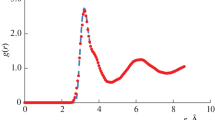Abstract
The melting of crystalline silicon and the cooling of liquid silicon are investigated using Molecular Dynamics. Both the Stillinger-Weber (SW) potential and the Tight-Binding Bond Model are used to calculate the forces. The electrical properties are investigated using an empirical pseudopotential method with a plane wave basis. The melting point of the solid is found to be about 2300K. The dependency of this temperature with cell size is investigated. On cooling, there are changes in some of the properties of the liquid: the energy per particle decreases, the diffusion constant decreases, and the low frequency electrical conductivity decreases slightly as the temperature decreases. Between 1180K and 980K the liquid undergoes a transition to a glassy phase. There are large changes in the pair correlation function, the SW three-body energy distribution, the diffusion constant, the density of electron single particle states and the electrical conductivity. All of these changes are consistent with increased tetrahedral bonding.
Similar content being viewed by others
References
F.H. Stillinger and T.A. Weber, Phys. Rev. B 31, 5262 (1985)
A.P. Sutton, M.W. Finnis, D.G. Pettifor and Y. Ohta, J. Phys. C 21, 35 (1988)
C.Z. Wang, C.T. Chan and K.M. Ho, Phys. Rev. B 39, 8586 (1989).
L. Goodwin, A.J. Skinner and D.G. Pettifor, Europhys. Lett. 9, 701 (1989)
N.W. Ashcroft and N.D. Mermin, Solid State Physics, (Holt, Rinehart and Winston, New York, 1976), p.765.
Y. Waseda, The Structure of Non-Crystalline Materials: Liquids and Amorphous Solids (McGraw-Hill: New York, 1980).
C.Z. Wang, C.T. Chan and K.M. Ho, Phys. Rev. B 45, 12227 (1992).
W.D. Luedtke and U. Landman, Phys. Rev. B 37, 4656 (1988)
S.J. Cook and P. Clancy, Phys. Rev. B, in press (1993).
P.B. Allen and J.Q. Broughton, J. Phys. Chem. 91, 4964 (1987).
V.M. Glazov, S.N. Chizhevskaya and N.N. Glagoleva, Liquid Semiconductors (Plenum, New York, 1969).
M.O.Thompson (Private communication).
J.Q. Broughton and X. Li, Phys. Rev. B 35, 9120 (1987)
Acknowledgments
This work was supported by a grant from the National Science Foundation (NSF grant number DMR89-3333). The Materials Science Center at Cornell is acknowledged for providing the use of IBM/RS6000 workstations. The authors are grateful to M.O.Thompson for suggesting this study and for frequent helpful discussions.
Author information
Authors and Affiliations
Rights and permissions
About this article
Cite this article
Horsfield, A., Clancy, P. A Tight-Binding Molecular Dynamics Simulation of the Melting and Solidification of Silicon. MRS Online Proceedings Library 291, 55–60 (1992). https://doi.org/10.1557/PROC-291-55
Published:
Issue Date:
DOI: https://doi.org/10.1557/PROC-291-55



